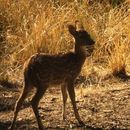mk
имиња во трошки


Axis deer have several vocalizations besides the bellowing that occurs during the mating season. They have a bark that is used during times of alarm or when an unusual object has been observed. This usually occurs among females and juveniles and is repeated back and forth. Another kind is squealing which is used by fawns when they get separated from their mothers. Moaning is associated with males during aggressive displays or when resting (Ables, 1977).
Communication Channels: visual ; tactile ; acoustic ; chemical
Perception Channels: visual ; tactile ; acoustic ; chemical
The axis deer has been introduced into Texas and Hawaii with good results. They do very well in captivity and can be seen at Zoos in the United States. Most are on private lands in the U.S., however, some are free-ranging.
US Federal List: no special status
CITES: no special status
IUCN Red List of Threatened Species: least concern
Axis deer have become an important resource for hunting in the United States.
The main foods utilized by these deer are grasses as well as flowers and fruits which fall from the forest trees. They will occasionally browse when it is necessary. During the monsoon season, grass and sedge species in a sal forest are an important food source. Another source of nutrition may come from mushrooms which are high in proteins and nutrients and are also found in sal forests (Moe and Wegge, 1994).
Plant Foods: leaves; wood, bark, or stems; fruit
Primary Diet: herbivore (Folivore )
The axis deer occurs historically in India and Ceylon. They have been introduced to Texas and Hawaii.
Biogeographic Regions: nearctic (Introduced ); oriental (Native )
In their native lands, the deer occupy grasslands and very rarely move into areas of dense jungle that may occur adjacent to them. Short grasslands are an important area for them due to a lack of cover for predators such as the tiger (Moe and Wegge, 1994). Riverine forests within the Bardia National Park in lowland Nepal are highly utilized by the deer for shade and cover during the dry season. The forest also provides good foraging with regard to fallen fruit and leaves that are high in nutrients needed by the deer. Therefore, the deer require open areas as well as forested areas within their home ranges for optimum habitat. Their total range incorporates a core area of about 32 hectares(ha) surrounded by foraging and cover areas of about 140 ha for females and 195 ha for males (Moe and Wegge, 1994). Some variation in range size occurs depending on the season as well as the sex.
Habitat Regions: tropical ; terrestrial
Terrestrial Biomes: savanna or grassland
Other Habitat Features: riparian
Average lifespan
Status: captivity: 15.0 years.
Average lifespan
Status: captivity: 20.8 years.
The Axis deer stands 0.6 to 1 m tall at the shoulder and has a body length of about 1.5 m (Walker, 1964). The body color is reddish with white on the belly, inner legs, and underneath their short tail. The males tend to be darker and to have black facial markings. They also have antlers composed of three tines which can reach lengths of almost a meter. Characteristic white spots occur in both sexes and run longitudinally in rows throughout the duration of the animal's life (Ables,1977). A dark dorsal stripe runs the length of the animal's back.
Range mass: 27 to 45 kg.
Other Physical Features: endothermic ; homoiothermic; bilateral symmetry
Sexual Dimorphism: sexes colored or patterned differently; ornamentation
Males tend to bellow during the mating season which may be a good indicator of when breeding begins.
Axis deer breed in April or May and have a gestation of about 7.5 months. They usually have two fawns but one or three is not uncommon(Walker, 1964). The number of fawns produced as well as the mating season may vary for deer in captivity; only one fawn is usually produced and mating may take place from May to August (Ables, 1977). First pregnancies usually occur between the ages of 14 to 17 months. The female usually maintains nursing until the fawn can safely roam with the herd (Walker, 1964).
Breeding interval: Axis deer breed once yearly.
Breeding season: Breeding occurs in April and May.
Range number of offspring: 1 to 3.
Average gestation period: 7.5 months.
Range age at sexual or reproductive maturity (female): 14 to 17 months.
Key Reproductive Features: iteroparous ; seasonal breeding ; gonochoric/gonochoristic/dioecious (sexes separate); sexual ; fertilization (Internal ); viviparous
Average birth mass: 3144 g.
Average gestation period: 226 days.
Average number of offspring: 1.03.
Average age at sexual or reproductive maturity (male)
Sex: male: 913 days.